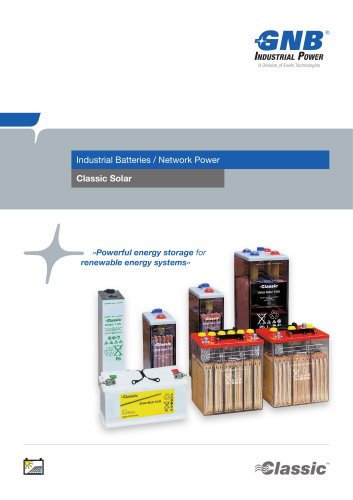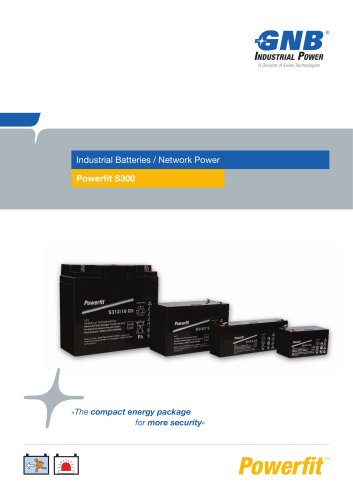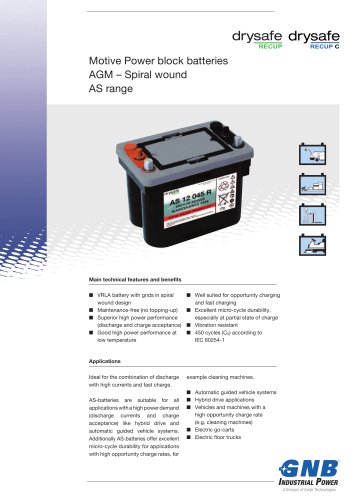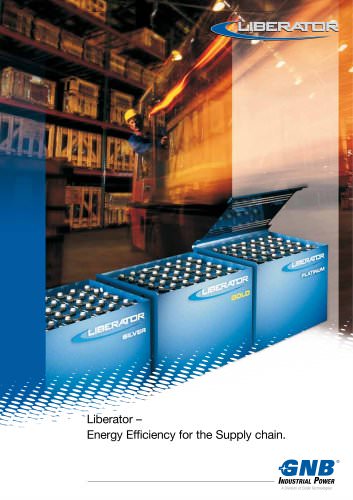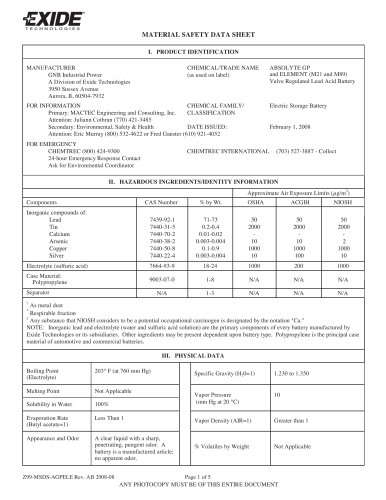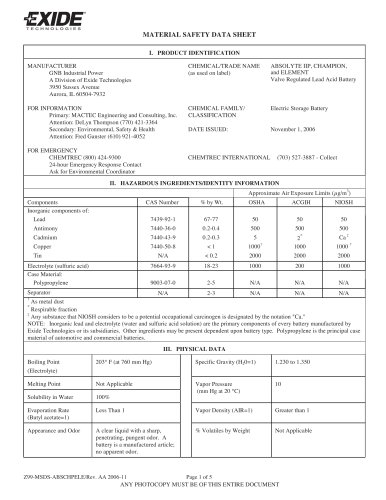 Website:
Exide Technolgies
Website:
Exide Technolgies
Catalog excerpts

I. PRODUCT IDENTIFICATION MANUFACTURER CHEMICAL/TRADE NAME Valve Regulated Lead-Acid Exide Technologies (as used on label) Battery (VRLA) 13000 Deerfield Parkway, Bldg. 200 Absorbed Electrolyte Battery Alpharetta, GA 30004 CHEMICAL FAMILY/ Electric Storage Battery FOR INFORMATION CLASSIFICATION Primary: MACTEC Engineering and Consulting, Inc. Attention: Juliann Cothran (770) 421-3485 Secondary: Environmental, Safety & Health DATE ISSUED: February 1, 2008 Attention: Eric Murray (800) 523-4622 Fred Ganster (610) 921-4052 Page 1 of 5 FOR EMERGENCY CHEMTREC (800) 424-9300 CHEMTREC INTERNATIONAL (703) 527-3887 Collect 24-hour Emergency Response Contact Ask for Environmental Coordinator II. HAZARDOUS INGREDIENTS/IDENTITY INFORMATION Approximate Air Exposure Limits (ֵg/m > 3 ) Components CAS Number % by Wt. OSHA ACGIH NIOSH Inorganic compounds of: Lead 7439-92-1 75-77 50 50 50 Electrolyte (no fluid/completely absorbed) sulfuric acid/water/solution 7664-93-9 14-16 1000 200 1000 Case Material: Polypropylene 9003-07-0 5-6 N/A N/A N/A NOTE: Inorganic lead and electrolyte (water and sulfuric acid solution) are the primary components of every battery manufactured by Exide Technologies or its subsidiaries. Other ingredients may be present dependent upon battery type. Polypropylene is the principal case material of automotive and commercial batteries. III. PHYSICAL DATA Boiling Point 203 F-240а F (for S.G. range) Specific Gravity (H > 2 0=1) 1.230 to 1.350 Melting Point Not Applicable F 17 to 11 (for S.G. range) Solubility in Water 100% Vapor Pressure (mm Hg) 77 Evaporation Rate (Butyl acetate=1) Less Than 1 Vapor Density (AIR=1) Greater than 1 Appearance and Odor A clear liquid with a sharp, penetrating, pungent odor. A battery is a manufactured article; no apparent odor. % Volatiles by Weight Not Applicable IV. FIRE AND EXPLOSION HAZARD DATA Flash Point : Not Applicable Flammable Limits: LEL = 4.1% (Hydrogen Gas in air) ; UEL = 74.2% Extinguishing media : CO > 2 ; foam; dry chemical Special Fire Fighting Procedures : Use positive pressure, self-contained breathing apparatus. Beware of acid splatter during water application and wear acid-resistant clothing, gloves, face and eye protection. If batteries are on charge, shut off power to the charging equipment, but, note that strings of series connected batteries may still pose risk of electric shock even when charging equipment is shut down. >
Open the catalog to page 1
IV. FIRE AND EXPLOSION HAZARD DATA (CONTINUED) Unusual Fire and Explosion Hazards : In operation, batteries generate and release flammable hydrogen gas. They must always be assumed to contain this gas which, if ignited by burning cigarette, naked flame or spark, may cause battery explosion with dispersion of casing fragments and corrosive liquid electrolyte. Carefully follow manufacturer's instructions for installation and service. Keep away all sources of gas ignition and do not allow metallic articles to simultaneously contact the negative and positive terminals of a battery. V....
Open the catalog to page 2
VI. HEALTH HAZARD DATA (CONTINUED) Effects of Overexposure - Chronic: Electrolyte : Possible erosion of tooth enamel; inflammation of nose, throat, and bronchial tubes. Lead compounds : Anemia; neuropathy, particularly of the motor nerves, with wrist drop; kidney damage; reproductive changes in both males and females. Carcinogenicity: Electrolyte : The National Toxicology Program (NTP) and the International Agency for Research on Cancer (IARC) have classified "strong inorganic acid mist containing sulfuric acid" as a substance that is carcinogenic to humans. This classification does not...
Open the catalog to page 3
VII. PRECAUTIONS FOR SAFE HANDLING AND USE (CONTINUED) Precautionary Labeling: POISON - CAUSES SEVERE BURNS DANGER - EXPLOSIVE GASES CORROSIVE - CONTAINS SULFURIC ACID KEEP AWAY FROM CHILDREN VIII. CONTROL MEASURES Engineering Controls and Work Practices: Store and handle in well-ventilated area. If mechanical ventilation is used, components must be acid-resistant. Handle batteries cautiously. Make certain vent caps are on securely. If battery case is damaged, avoid bodily contact with internal components. Wear protective clothing, eye and face protection, when charging or handling...
Open the catalog to page 4
IX. OTHER REGULATORY INFORMATION (CONTINUED) Approximate Toxic Chemical CAS Number % by Weight Lead 7439-92-1 75-77 Sulfuric Acid/Water Solution 7664-93-9 14-16 If you distribute this product to other manufacturers in SIC Codes 20 through 39, this information must be provided with the first shipment of each calendar year. Note: The Section 313 supplier notification requirement does not apply to batteries that are "consumer products". CAA: Exide Technologies supports preventative actions concerning ozone depletion in the atmosphere due to emissions of CFC's and other ozone depleting...
Open the catalog to page 5All Exide Technolgies catalogs and technical brochures
-
GNB_MP_Overview
16 Pages
-
GNB_MP_2100
16 Pages
-
GNB Classic OCSM
8 Pages
-
Absolyte GP
20 Pages
-
_Powerfit
4 Pages
-
_Marathon_M_FT
16 Pages
-
_Classic_OGi
16 Pages
-
TENSOR
8 Pages
-
MARINE
12 Pages
-
battery
12 Pages
-
Sonnenschein SOLAR
12 Pages
-
MARATHON
20 Pages
-
Block batteries
12 Pages
-
classic
12 Pages
-
Marathon M-FT
16 Pages
-
sprinter
12 Pages
-
Classic Solar
12 Pages
-
Absolyte® CP
12 Pages
-
Classic OGi
16 Pages
-
Sonnenschein A400
12 Pages
-
S300
4 Pages
-
GF-Y
2 Pages
-
AS
2 Pages
-
Classic FT
2 Pages
-
TENSOR
2 Pages
-
TENSOR
4 Pages
-
2100 OP
16 Pages
-
ATEX
8 Pages
-
EPzV
2 Pages
-
Classic EPzS
2 Pages
-
Element batteries
6 Pages
-
EDGE
4 Pages
Archived catalogs
-
Lead Oxide
4 Pages
-
Flooded Lead Antimony Cells
6 Pages
-
Absolyte® GP and Element
5 Pages


















